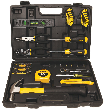Knowing the proper methods for finding wall studs can come in exceptionally handy in a variety of situations. The first scenario that you may need to find a wall stud is something as simple as hanging a picture. Secondly, finding wall studs would be helpful if you wanted to do some electrical work. A third reason that you may want to find some wall studs would be if you were going to be doing some renovations or remodeling. Finding wall studs
- Use the proper tools. Perhaps the simplest and easiest method for finding walls studs is to use a tool designed expressly for that purpose. Simply by turning a stud finder on, and running it over the wall. On most models when a stud is detected, you will be able to hear a solid tone and a small light bulb will light up.
- Look for clues. If you look closely on most walls, or in the right light and angle, you can find some slightly raised nail heads. These nail heads are indicators of a stud since they are what is anchoring the drywall to the studs themselves. That being said, this method can be fairly difficult if the wall was mudded properly prior to painting.
- Start at a window or corner. Two places that you are guaranteed to find a stud is at a window or corner of a wall. According to the building codes in most cities in the United States, you will find a stud spaced every 16 or 24 inches from these points. Simply measure out that far, and you should find the stud that you want.
- Look for an electrical outlet. Outlets and light switches, again according to code, are supposed to be mounted to the sides of a stud. This means that if you find one of these, then you have found a stud. Once again, if you measure 16 or 24 inches away from these places you will find another one.
- Knock on wood. Another indicator of where a stud might be is through the use of sound. Simply knock on the wall, roughly 16 or 24 inches away from a corner, window, or outlet, and see if you can get a solid sound. If you do, then you have found a stud. However, if it sounds like you are knocking on something hollow then you have only found some unsupported drywall.
Author Bio
Lee Wyatt
Contributor of numerous Tips.Net articles, Lee Wyatt is quickly becoming a regular "Jack of all trades." He is currently an independent contractor specializing in writing and editing. Contact him today for all of your writing and editing needs! Click here to contact. Learn more about Lee...
Food Storage Ideas
In times of economic hardship having food storage can often be a literal lifesaver. But it's not always the best idea to ...
Discover More
Painting over Wallpaper
Are you looking for a way to change the look of a room that has wallpaper, but you don't really feel like pulling the ...
Discover More
Cleaning Bird Poop from Your Car
Cleaning bird poop from your car is a task that every vehicle owner should take care of. If you leave it till later, ...
Discover More
More Home Improvement Tips
Finding Load-Bearing Walls
Most people understand that all exterior walls are load bearing, but it is unsafe to assume that all interior walls are ...
Discover More
Soundproofing Home Theaters
Whether you currently have a home theater, or you are simply planning on having one later, be sure that you get the most ...
Discover More
Understanding Wallboard Finishing Levels
If you are thinking of having any type of wall work done in your home, then it is a good idea to understand the basics. ...
Discover More

Comments